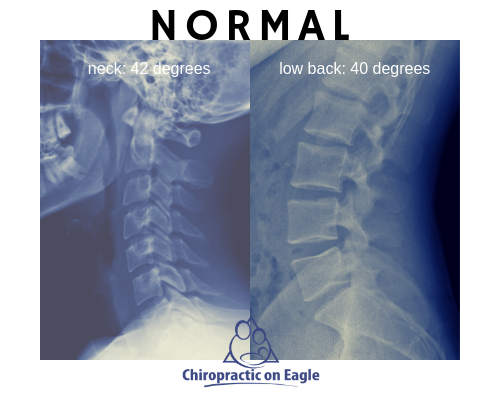Got Curve?

Normal Neck and Low Back Curve (lordosis) is 42 and 40 Degrees respectively, from the side.
What is yours? 40, 30, 12 or maybe even 0 degrees? You should know. It could be causing your pain.

Just like there are normal values for other health indicators, like high blood pressure (120/80), cholesterol (<5.2 mmol/L), oxygen saturation levels (>97%), etc…there is absolutely a normal value for posture and alignment.
Comparing yourself to ideal normal is vital for your health.
A recent meta-analysis (study) “demonstrated a strong relationship between low back pain and decreased lordosis, especially when compared with age-matched healthy controls. Among specific diseases, low back pain by disc herniation or degeneration was shown to be substantially associated with the loss of lumbar curve.” (Spine J. 2017 Aug;17(8):1180-1191)
This is also the case with neck pain. When normal alignment is lost, pain, headaches, dizziness, and general stiffness can result. Even arm pain described as a “pinched nerve” can result of your neck being out of alignment.
Digital x-ray technology allows us to be able to precisely measure alignment.
While not always perfectly correlated, in my clinical practice, I see many patients who have lost their normal alignment from the side (curve) suffering from more pain, disability, arthritis, and ability to move than those with normal alignment.
With our ever-increasing sedentary lifestyle, our constant sitting, and our addicted to “looking-down” posture on our phones – our spines are taking a beating. Every day we wake up and do it again (hopefully you sleep in the correct position to give your spine a rest). This causes pain and degeneration (spinal arthritis) and decreases our enjoyment in life.
In our office we focus on finding the cause of your pain. Just like you would expect your family doctor to take your blood pressure or order blood work to find the cause of your problem, we want to find the cause of your pain.
A full examination including all available testing ensures we don’t miss anything. If we can find the cause of your problem, there is very good chance we can help you fix it. Together, we can map out a recovery plan based on your goals, the best available evidence, and our clinical experience.
What’s your curve at?

Chiropractic on Eagle
2:30 – 6:00 PMTuesday 7:30 – 10:45 AM
2:30 – 5:30 PMWednesday 2:30 – 6:00 PMThursday 7:30 – 10:45 AM
2:30 – 5:30 PMFriday ClosedSaturday ClosedSunday Closed
